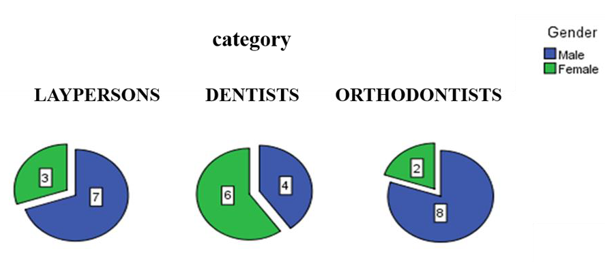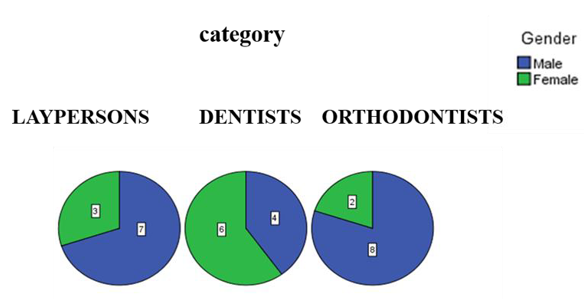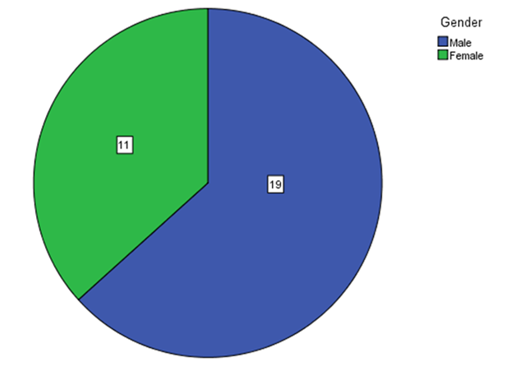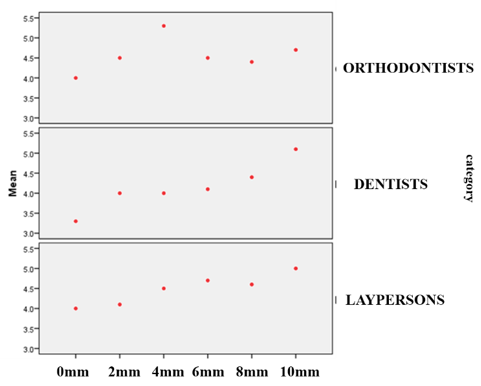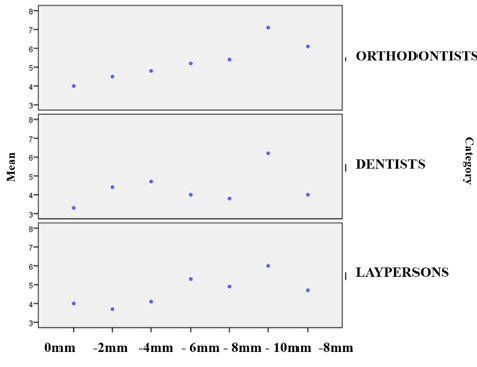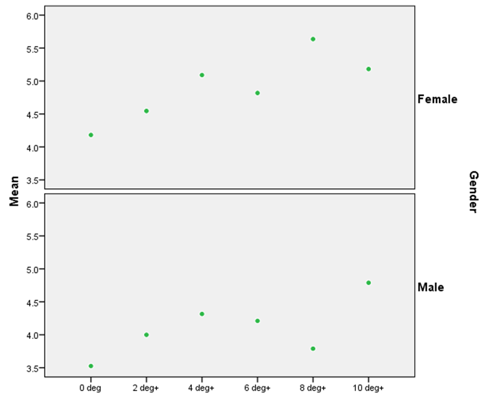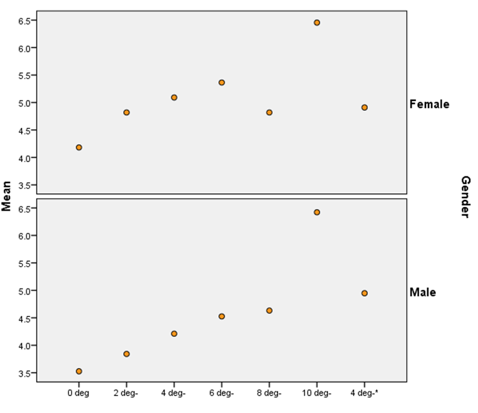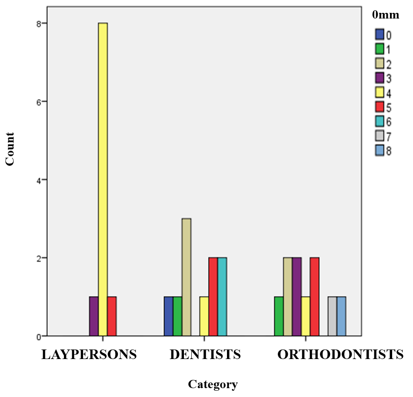Introduction
The attractiveness of an individual is determined by the relationship between the various components of the craniofacial complex. Current Orthodontic diagnosis and treatment plan is also based on the arrangement of the soft tissue complex.1, 2 This makes the execution of treatment plan very challenging as beauty is a subjective factor leading to different facial evaluations. Therefore it is very important for Orthodontists to know the patient’s perception of facial attractiveness and the expected treatment outcomes for formulation of patient-centred treatment goals.3, 4
The Orthodontic literature mentions an array of studies that have emphasized the need of set of norms for the facial attractiveness.5, 6 Unfortunately this does not hold true universally as there exists variations in the facial pattern for different ethnic groups, ages and sexes around the world. Also when the profile view is considered the sagittal prominence of the mandible is an important determinant of attractiveness. The average value of which parameter varies with age, gender, and ethnicity.7, 8, 9
Facial soft tissues have been studied conventionally by cephalometrics, photographs, silhouettes, line drawings, and artist sketch techniques, and differences found between the genders were mainly related to the size and timing of growth. Only few studies in the literature have evaluated the overall shape of face with respect to the age-related changes and sexual dimorphism. This could be due to the inability of the older methods to assess the facial shape accurately or the inconsistency of the results obtained due to their methodological differences. 10, 11 To overcome these, newer techniques were studied such as digital imaging. It gives a more practical representation of facial aesthetics as compared to the older methods, in that the changes in profile are related to the soft tissue contours. All the changes are specific for an individual subject eliminating the risk of bias also it enables the evaluator to create a homogenous group artificially on which profile alterations are made. However the main disadvantage with this method is the potential inaccuracy of the prediction as the Orthodontic patient population is diverse with a mixture of genetic and ethnic backgrounds and we usually attempt to force them into a homogenous mould.12
Our aim should be in finding common ground on which we can meet to accept reasonable objectives, and common norms to evaluate patients solely by an Orthodontic interpretation of aesthetic harmony. This necessitates the need to check the perception of the beauty of the faces by the laypersons and the professionals dealing with the facial attractiveness in their day-to-day life. Few researchers have reported general agreement between orthodontists and the laypersons while others suggest that professionals and laypeople perceive facial esthetics differently. Controversy still remains in the literature as to whether laypeople and professionals agree in their perceptions of facial attractiveness. 13, 14, 15
This study was carried out to compare and evaluate the perception of facial attractiveness of different antero-posterior proportions of the chin which was altered digitally in a female subject among laypersons, dentists and Orthodontists.
Materials and Methods
The study was conducted at the Department of Orthodontics and Dentofacial Orthopaedics, Institute of Dental Sciences, Bhubaneswar approved by the Institutional Ethics Committee, Institute of Medical Sciences and Sum Hospital, Siksha ‘O’ Anusandhan (Deemed to be University) [Refno/DRI/IMSSH/SOA/18130/2020]. The subjects who reported to the Department of Orthodontics & Dentofacial Orthopaedics, Institute of Dental Sciences and SUM Hospital, Bhubaneswar, Odisha for Orthodontic treatment was advised for standard pre-treatment diagnostic radiographs and digital photographs. The criteria of inclusion was Class І incisor and molar relationship, Class І skeletal pattern with an average lower anterior face height/total anterior face height and a straight harmonious profile. Excluded subjects include previously treated Orthodontic patients, dentoalveolar abnormalities such as clef lip and or palate and facial asymmetry.
A 27 years old female, meeting the above mentioned criteria was selected as a subject for this study. A total number of 30 evaluators was selected from the Odisha population and divided into 3 groups of 10 persons each:
Group 1- laypersons; belonging to various professions (non-medical within age range of 20-45 years
Group 2- dental professional; Dentists with minimum 5 years of clinical experience within age range of 30 to 65 years
Group 3- Orthodontists with minimum 5 years of clinical experience, within age range of 35 to 65 years.
A colored digital photograph of the female subject was obtained, from canon digital camera 700D. This image was taken in a standardized procedure by positioning the subject 5 ft. from the camera with the head in the natural head position and the lips at rest. The facial profile was digitally altered in the antero- posterior direction in the region of the lower third of the face at the soft tissue point sublabiale using Adobe Photoshop software (22.1 version).
The position of the mandible was altered by stretching and compressing sublabiale antero-posteriorly in 2 mm increments using Adobe Photoshop software program to produce Class III /concave facial profiles & Class II/ convex facial profiles respectively. The antero-posterior alteration of sublabiale point was done parallel to Frankfort horizontal plane and perpendicular to the TVL line without affecting the vertical height of the face or any other part of face such as lips or nose. These alterations generated a series of 11 different profile images. Areas around the alterations were airbrushed to disguise any obvious changes and to remove any unrealistic areas, especially in lip morphology. All the images were standardised to width, height and resolution of 5184, 30456 and 72 pixels respectively.
A two page questionnaire was used for ranking the profile images (Figure 1). The first page included detailed information regarding the age, gender, and profession of the evaluators, the second page had the VAS scores to be given for each profile picture. A duplicate image of one of the altered 11 profiles (-8 mm altered photograph) were included to assess intra-examiner repeatability and reliability, hence a total of twelve digitized images were presented, to be ranked by the evaluators. The images were randomly arranged and presented to the evaluators. The participants were then asked to evaluate and rank the 12 images on a 10-point VAS scale, allocating a score of 0 to the most attractive profile and 10 to the least attractive profile. They were asked to rank according to their opinion of the attractiveness of these profiles.
Statistical Analyses
Data of rankings by the 30 evaluators for the 12 altered images of the female subject was recorded as per the protocol of the study. The data collected in the process were scrutinized, coded and entered into IBM SPSS Statistics 24.0, SPSS South Asia Pvt. Ltd. and analysed by the statistical procedure as mentioned below:
Frequency distribution of age, gender, was computed using paired t-test and chi -square test
Comparison of mean values of different anterior advancement of lower third of face at point sublabiale among the three group of evaluators (orthodontists, dentist and laypersons) using independent sample t-test.
Comparison of mean values of different posterior reduction of lower third of face at point sublabiale among the three group of evaluators ( Orthodontists , dentist and laypersons ) using independent sample t-test
Measures of central tendency mean and standard deviation were used
The cut off value for test of significance was taken as p<0 05
Results
To compare and evaluate the perceptions of the different antero-posterior proportions of the chin on the attractiveness of soft-tissue profile, this study was carried out on a female subject whose profile photograph was digitally altered at the sublabiale point to create a set of 12 photographs which was presented among 30 observers (laypersons, dentists and orthodontists) 10 observers in each category for evaluation.
The analysis and interpretation is presented in this chapter. The first section presents demographic profile of the sample. Second section explains the differences in the mean scores of the three groups in accordance with the various antero-posterior proportions of advancement in the lower third of the face. The third section explains the differences in the mean scores of the three groups in accordance with the various antero-posterior proportions of reduction in the lower third of the face.
Demographic profile of the evaluators
Figure 2, Figure 3, Figure 4 depicts the distribution of males and females across the three groups of evaluators. There were 8 males and 2 females in the Orthodontists group, 4 males and 6 females in the dentists group and 7 males and 2 females in the laypersons group.
Mean VAS score from baseline in each category of observer
Figure 5 presents mean VAS scores for the alterations of chin in the anterior direction for each category of evaluators; Figure 6 presents the mean VAS scores for alterations of chin in the posterior direction for each category of evaluators, Figure 7 presents the mean VAS scores in females and males separately for alterations in the anterior direction, Figure 8 depicts the mean VAS scores for alterations in the posterior direction in males and females separately.
Table 2
VAS scores for each photograph scored by each category of observer
Discussion
Defining beauty and attractiveness is a very complex and subjective matter of discussion as it is increasingly accepted that what is attractive to a clinician based on their experience and training may not agree with what patients think. This disparity in the opinion can lead to patients getting dissatisfied with the treatment outcomes which makes treatment planning difficult. Thus, orthodontists and patient should reach to an agreement on a plan that addresses the patients’ facial aesthetic concerns which will make the communication process easier between them.16 Therefore, our research was aimed to establish facial profile preferences of the various group of evaluators.
Attempts have been made by many researchers to establish norms in group of individuals for a normal facial form with clinically acceptable occlusion and good facial appearance. However, facial attractiveness is highly influenced by race and culture and most of the studies have been performed on white population and very less data is available on Asian and Middle Eastern population. So, this research was done to compare and evaluate the perceptions of orthodontists, dentists and laypersons from Odisha population on a set of digitally altered profile images of a female subject.
Since, we as orthodontists are concerned with correction of mainly the lower third of the face, the relative positioning of the maxilla and mandible to each other in the sagittal plane is of great importance for profile establishment.16 More so sagittal prominence of mandible is an important determinant for the attractiveness of an individual. Hence, our study design involved alterations in the antero-posterior proportions of the lower third of the face especially at point sublabiale.
In contrast to some of similar studies conducted by various authors we have taken image of a female subject with a straight profile instead of class II or class III profile.17, 18
In addition to this, colour photographs which have been digitally altered using Adobe Photoshop software were taken for evaluation as they are not only valid and reproducible but also are more practical, thus rendering the decision making process easy especially for laypersons.19
Although a study performed by Shelly et al20 has explained the need of facial profile silhouettes rather than colour photographs as they would remove some of the distracting non-metric variables such as face colour, hair and cultural environment but this might be rational while assessing the effect of treatment on facial profiles. However, for evaluation of perception of facial attractiveness it is important to consider the entire face. This explains the reason for us choosing coloured digital photographs over profile silhouettes.
Previous literature shows that many authors have studied and proved the importance of the TVL in facial aesthetics as a reference line for diagnosing dentofacial deformities and for treatment planning as it shows the smallest standard deviations when compared to commonly used reference lines. Also, it is independent of the chin position.21 The alterations were made parallel to the true vertical line to create eleven separate images ranging from zero (normal profile) to 2, 4, 6, 8, 10 mm increments and decrements respectively. The minus 8 mm photograph was included twice to assess intra-examiner repeatability and reliability.
Each set of photograph (twelve in number) of the female subject was given to an observer randomly for scoring by visual inspection. The observers were from three categories i.e. specialist professionals (orthodontists), professionals (dentists) and laypersons with 10 persons in each category. Each evaluator registered their ratings on a VAS linear scale on a questionnaire form, where the score of 0 was considered as most attractive profile while 10 the least attractive one. Results obtained from our study on intra-observer reliability with VAS are in agreement with previous studies .VAS scale was chosen as the tool for evaluation since it is more precise, rapid, easy and readily accepted tool for scoring attractiveness.22 There were nineteen males and eleven females in total, spread across all the three categories. The cross tabulation of the gender and the observer categories did not show any statistical significance, thereby, meaning that the difference in the ratio of males and females in each of the observer categories did not influence the study as concluded from various studies.23, 24
When the ratings of the three categories were compared it was seen that the scores showed a linear trend of increasing values as the alterations in the photographs increased. Thus -10mm and +10 mm altered images had the highest scores in all three groups (Laypersons: 6±1.41, Dentists: 6.2±1.75, Orthodontists: 7.10±1.91).
The differences in the scores of the three groups were not statistically significant (p>0.05). This showed that irrespective of professional training all the observers could easily discern the distortion in facial features at the extreme position. All the three groups gave maximum VAS score to the most concave or convex facial profile, which is in agreement with a number of studies.25, 26
The most attractive profile recorded for all the categories was the one with no alterations. This finding is also supported by various studies that have discussed about the differences in aesthetic perception between clinicians and laypersons where it was seen that straight profile showed increased acceptance among all. In the assessment of the photographs the orthodontists also assigned higher scores for every photograph compared to the scores assigned by the dentists and the laypersons. This manifests that orthodontist’s perception of the facial feature deflection, was more subtle compared to dentists and laypersons. This is in accordance with study by Shaw et al27 and Orsini et al28 which showed that orthodontists are conditioned to take an overly critical perception on any divergence from normal facial appearance due to their education on aesthetic norms and standards.
The differences in the mean scores assigned by the orthodontist and the dentist for different alterations of facial asymmetry were not statistically significant. This proves the general practitioners and orthodontists’ clinical acumen to recognise the patients’ facial feature deviations from the norms is similar.
The only exception was the difference in the scores for the - 8 mm photograph where the difference in scores by the three groups were statistically significant. This could be because, the -8 mm altered photograph was given twice for evaluations, in order to remove bias. As the response to this photograph was tabulated twice, the difference in the results were statistically significant.
Likewise, the difference in the scores assigned by the orthodontists’ and laypersons were also statistically not significant except for the scores at - 8 mm altered photograph.
Also the difference between the mean scores given by the dentists and laypersons were also statistically significant at any of the alterations of the photograph. The scores given by male and female observers were also not found to be statistically different except for the -8mm photograph.
It is very important for orthodontists to remain updated with the beauty trends in order to deliver patient centred treatment plans as the ideals and standards of beauty change with time. In the past, a flattened and retrusive profile was preferred however in modern times profile with fuller and protrusive lips is preferred. According to Foster29 males with a straight profile and females with convex profile is perceived as attractive which is in contrary to the results of our study which shows the preference of straight profile by all. Another study conducted by Kuroda S30 in Japanese population perceived slight mandibular retrusion to be more favourable than normal. In addition studies by many authors also concluded that orthodontists preferred straight or bimaxillary retrusive profiles whereas laypersons preferred protrusive profiles.31 On the other hand, a study by De Almeida MD32 supports our findings, that female models with prognathic mandible were rated as less attractive. Moreover, the acceptance of a straight profile over protrusive or retrusive profile was concluded by lot of studies.33 This clearly shows that the perception of facial attractiveness is not universal and it varies in race, ethnicity and cultural background.
Many authors have concluded from their studies that there is no difference in perceptions between the laypersons and professionals when it comes to perception of facial aesthetics which is also in accordance with the results of our study where straight profile was perceived as attractive by all.34 However, there are many studies in the literature which do not agree with the same.
So, it is concluded from our study that a straight profile in a female subject is perceived as the most attractive by all the three categories of evaluators. Although orthodontists’ were harsher at identifying a favourable profile compared to dentists and laypersons.
Future studies should include more participants with different age groups, similar proportion of sex, and the use of modern technology including 3D imaging and animation which could also broaden the study design.
Conclusion
The study evaluated the perceptions of facial profile attractiveness among 10 orthodontists, dentists and laypersons in terms of variable mandibular sagittal positioning, relative to TVL in a set of digitally altered profile photographs of a female subject. The results obtained cannot be generalized owing to differences in opinions among various races, ethnic background and cultural environment but it indicates preferences in facial profile attractiveness by Orthodontists, dentists and laypersons in Odisha population.
It was seen from the results of this study that the straight profile was perceived as the most attractive by all the three group of evaluators and the least attractive was the one with the most concave and convex profile with protrusive or retrusive mandible.
The laypersons and dentists were more tolerant of mild mandibular alterations as compared to the orthodontists.
The gender of the evaluators did not influence the perceptions of facial profile attractiveness. This information is very valuable to the clinicians in the treatment planning.
As the patients become more aesthetically inclined and educated, it is very important to understand patients’ expectations of treatment to provide contentment, failure of which can lead to patient disappointment even after delivering best clinical treatment results. Orthodontists must consider patients opinions before treatment planning rather than just aiming to achieve standards without considering individual variance.
The concept of beauty is very subjective and is dependent on individual judgement, hence, a single study cannot be applied to all. Therefore, it can be
concluded that this study provides a basis for understanding the facial profile preferences by different groups of people as well as their degree of sensitivity on the same, which can also help orthodontists to devise final treatment plans.
Further studies involving bigger samples shall create stronger evidence on this prospect.

